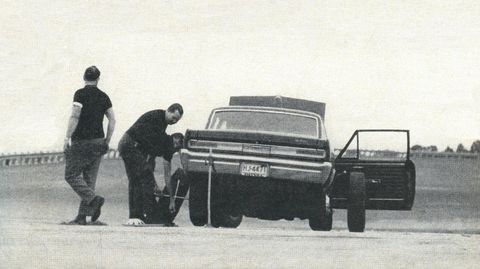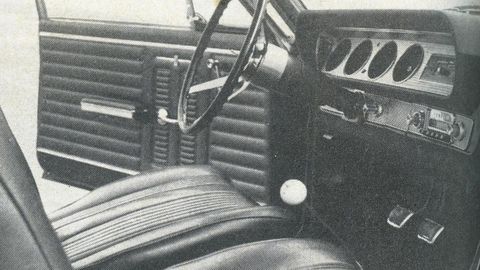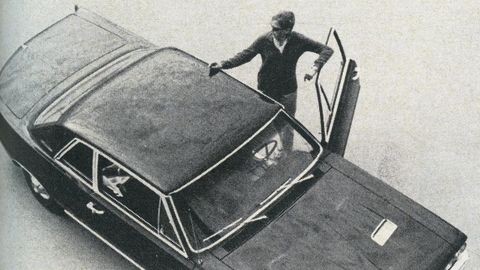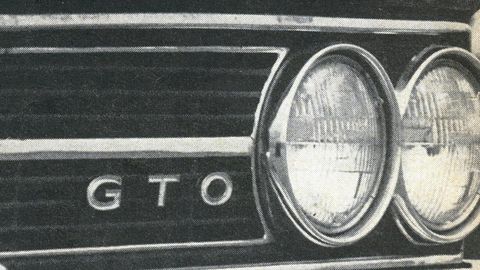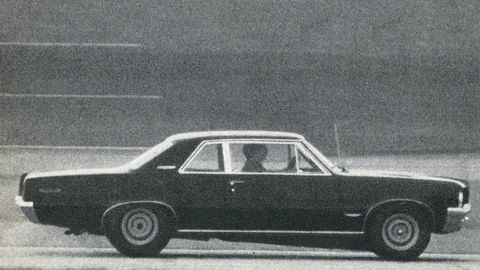From the March 1964 Issue of Car and Driver.
Most knowledgeable enthusiasts reacted negatively when Pontiac announced that their new Tempest sports model was to be called the GTO. They felt, as we did, that Pontiac was swiping a name to which it had no right. Like Le Mans, Grand Prix, Monza, Spyder and 2+2, this was another of those hard-to-digest bits of puffery from the Detroit/Madison Avenue axis. Our first look at the car made us feel a little better, because it is handsome, and then we got a call from correspondent Roger Proulx, raving about the car’s acceleration and handling, so we arranged to test a Pontiac Tempest GTO.
This was the most exhaustive and thorough road test we have ever done. We used two nearly-identical cars, the differences being that one car had the shorter-ratio manual steering while the other had power; the manual steering car was also equipped with metallic brake linings. We drove our two cars unmercifully. One was driven from Detroit to New York City, used for ten days by every member of the staff, and then driven from New York to Daytona Beach, Florida, carrying the managing editor, his wife, and three active children. This car—the manual steering, metallic brake version—was driven over 3000 miles. The other car was driven about 500. We ran dozens of acceleration tests on the two cars, plus many, many laps of the Daytona International Raceway’s tri-oval and road circuit.
It was our original intention to borrow a Ferrari GTO and to run the two against each other at Bridgehampton’s road racing circuit and on the drag strip at Westhampton. We had engaged Walt Hansgen to drive the Pontiac and Bob Grossman to run his own Ferrari. Unfortunately Grossman’s Ferrari was tired from a season of racing, and was not considered fast enough to really be a match for our Tempest. We then canvassed all the GTO owners in this country and simply could not get one of those lucky gentlemen and the weather to cooperate simultaneously. As a result, we drove two Ferrari GTO’s, but we were never able actually to run the Tempest against either one of them.
Although it would have been great fun and quite interesting to run the Ferrari racing car against Pontiac’s similarly-named touring car, our tests showed that there really was no effective basis for comparison—the Pontiac will beat the Ferrari in a drag race, and the Ferrari will go around any American road circuit faster than the stock Tempest GTO. We are positive, however, that a Tempest like ours, with the addition of NASCAR road racing suspension, will take the measure of any Ferrari other than prototype racing cars or the recently announced 250-LM. We should also point out that our test car, with stock suspension, metallic brakes and as-tested 348 bhp engine will lap any U.S. road course faster than any Ferrari street machine, including the 400 Superamerica. Not bad for an actual delivered price of 3400 dollars, wot?
It was a shade over ten years ago that events in Detroit took a turn for the better and started the trend that ultimately resulted in the Tempest GTO. At that time, GM announced the Corvette. It was a funny car, hooted and jeered at by enthusiasts and by-passed by the great unwashed in favor of its more understandable competitor, the two-seater Thunderbird.
From those humble beginnings (with the late-fifties prompting of a robust and growing imported car market), came a host of better, more interesting cars from Detroit. The success of the Corvette and the sports-type Corvair Monza led the other GM divisions to build similar cars, particularly in the B-O-P compact lines. Buick and Oldsmobile leaned toward the concept of “Little Thunderbirds,” cars with bucket seats and floor-mounted shift levers, but little else of a sporting nature. Pontiac, God love ’em, went the hairy-chested route and came up with our test car, the best American car we have ever driven, and probably one of the five or six best cars in the world for the enthusiast driver.
Obviously, personal preference must come into play here. There are many of our readers who think that a Sprite is the absolute epitome of grand touring, while others feel that no car should have a displacement greater than 1500cc. Add to these the purist who wouldn’t drive an American car if his life depended on it, and you have a pretty fair-sized body of opposition. We respect their differing opinions and will defend to the death their right to express them, but we will stand or fall on our enthusiasm for the Tempest GTO.
In 1963 we were a bit stunned by a Mercury Marauder that had 427 cubic inches, 425 horsepower, good handling, and performance that, to us, was absolutely breathtaking. The Tempest GTO is better. First of all, its smaller outside dimensions make it a lot more fun to drive; and, second, it goes faster.
Our test car was equipped with the 389-cubic-inch, 348 horsepower, V-8 engine with hydraulic valve lifters and a compression ratio of 10.4 to one. It had the new GM “Muncie” four-speed transmission and Pontiac’s Saf-T-Trak limited-slip differential. The rear axle ratio was 3.90 to one, and the brakes had metaIlic linings. The car had standard Tempest GTO suspension (slightly stiffer valving in the shocks) and manual steering with an overall ratio of 20 to 1, substantially faster than the standard manual steering ratio of 26 to 1, but slower than the power steering’s 17 to 1. We preferred the power steering-not because the manual set-up was too stiff, but because it still wasn’t quite fast enough.
A word of caution here: Pontiac is forced by the realities of commerce to build cars for little old ladies and GM executives as well as enthusiasts. It is quite possible to go to your dealer’s for a demonstration drive and find yourself in a GTO of infinite dullness-an automatic-transmission-, power-operated-seat-, tinted-window-car with little to distinguish it from a Chevelle, a Buick Special, an Olds F85, or any other semi-visible American car. The GTO that delights the executive from the fourteenth floor of Detroit’s General Motors Building is not going to be the rabid enthusiast’s dish of tea. To buy a car like our test car you should either get hold of a catalog and memorize the options you want, or seek out a livewire dealership like Royal Pontiac in Royal Oak, Michigan, the firm that loaned us our GTO.
Royal is run by a man named Ace Wilson, who must be what regional sales managers ask Santa Claus to bring them for Christmas. His dealership is big and bright, with clean modern architecture and a whole staff of knowledgeable salesmen and mechanics. Royal is Pontiac performance headquarters, and a Royal license plate frame on your GTO or Grand Prix is enough to send teenagers into orbit anywhere in the United States. Royal even has its own line of accessories and speed equipment, certain combinations of which give the proud GTO or Catalina owner the right to call his car a Royal Bobcat, and to fit it with small black and white emblems to that effect.
Our test cars were Bobcats. This means that they were basically stock Tempest GTO’s with the following changes:
1. The main jets were changed to .069 in on all three carburetors for maximum acceleration. Normally, the center carburetor runs lean (.066 in) for cruising economy, with rich jets (.073 in) on the outboard carburetors for occasional bursts of speed. The Royal treatment gives a more even mixture distribution at a slight increase in steady-speed gas consumption.
2. A progressive-action throttle linkage is installed to calm the beast down for boulevard use; it’s also more accurate than the stock linkage.
3. The distributor is modified to limit centrifugal advance to 7 ° (14 crankshaft degrees) and initial advance is set at a whopping 20-22° (total advance, 34-36°, is reached at 3600 rpm). This makes a tremendous improvement in low-end response (i.e., below 3600 rpm) but substantially raises the octane requirement.
4. The heat riser is blocked off, a special (thin) head gasket from the Super-Duty 421 engine is installed and still more compression is gained by installing Champion J-I0Y plugs without gaskets.
5. Finally, special fiber-insert rocker arm retaining locknuts are installed which permit the hydraulic lifters to function as a solid lifter-operating at 90 percent bleed-down.
As you can see, these changes are neither extensive nor complicated, and fall more into the area of maximum tuning than that of modification or “hopping up.” The net result is an enormously strong engine with the capacity to spin its rear wheels in every gear, in spite of a limited-slip differential! The only penalty we noticed was that the car would knock like twenty-five poltergeists at a seance when anything but Sunoco 260 premium fuel (about 102 octane) was used.
Were we to buy a GTO (and there’s a good chance at least one of us will), our selection might go something like this. A GTO is basically a $2480 Tempest Le Mans with a $296 extra-equipment package that includes a floor shift, 389 engine, dual exhaust, stiffer shocks, “exterior identification” and a choice of super-premium tires or whitewalls. The four-speed, all-synchro transmission is $188 extra, and we’d gladly pay $115 to get the hottest (348 bhp) engine. The shorter axle ratios are only available with metallic brakes, HD radiator and limited-slip differential ($75.00 for the lot). Quick steering (20:1) is part of the handling option, though HD shocks and springs alone are only $3.82. The “wood”rim steering wheel is $39, and from there on in, it’s trimming the window with fuzz (like $36 for custom wheel covers). With every conceivable option on a GTO it would be difficult to spend more than $3800. That’s a bargain.
We find the GTO quite handsome, except for those phony vents that GM Styling’s Bill Mitchell insists upon hanging on everything. Unlike the Sting Ray, the GTO has only the ones on the hood, so we can say it could be much, much worse. Our test car was a rich dark blue with black U.S. Royal Red Line tires and very conservative wheel covers. There was nothing to give away the presence of the ferocious beast concealed inside, and yet the car would draw admiring glances wherever it went. Whether it was the car’s restrained good looks or the threatening grumble from the four (count ’em, four) shiny tail pipe extensions, we never learned.
Once inside, everything seems to be just about where you would have put it in a car of your own design. The optional steering wheel is wood-looking plastic that had us completely conned. To our embarrassment, some smart aleck who’d read the catalog pointed out our mistake and made us feel like General Motors had really taken us. Wood or not, it’s handsome as hell and an excellent piece of fakery. The instruments are all well-placed and legible, except for the tachometer, which is terrible-it’s too far to the right to be glanced at during a hard run, and, worse, it’s the wand type that sweeps horizontally across a four-inch quadrant and is practically impossible to read anyway. The speedometer is just slightly left of center in the panel and it has a typical 270 degree clock-type face. Our choice would be to swap the tach and speedometer locations, substituting a Sun SST (270 degree) tach for the factory’s $53.80 optional tach.
The transmission lever is nicely placed immediately next to the driver’s thigh. It has the now famous Hurst linkage which is amazingly short and unerringly accurate. The sports car driver’s first tendency is always to try to make the gate wider than it is, and the shift pattern more complicated. After a little time in the car, however, the brutal simplicity of that great tree-trunk of a lever begins to reassure you and you start throwing shifts with the same slam-bang abandon as the drag racing types. Our photographer drove the car and commented that he was used to driving imported cars and he had a hard time getting used to the extreme closeness of the GTO’s gate. Kismet.
The so-called bucket seats. in the GTO are the same as those in the Corvair Monza or any of the B-O-P compacts. That is to say they are not buckets at all, but actually individual front seats with a modicum of lateral support. We’d like the car better if the seats wrapped around farther and were more firmly constructed, but that’s the breaks. In one way, the softness is a good deal, because anybody who’s a middleweight or bigger will compress the seat cushion all the way anyway, and then it becomes quite satisfactory. Fore and aft adjustment on the front seats is excellent provided you have the manual adjustment—the power assisted system limits travel enough to preclude any kind of straight-arm driving technique for would-be heroes. Rear-seat room is cramped for three—it is, strictly speaking, a four seater.
Driving this car is an experience no enthusiast should miss. Unfortunately, few Pontiac dealers will have GTO demonstrators with the proper equipment on them, but if you can get your hands on one like we tested, it’s almost worth stealing it for a few minutes of Omigod-we’re-going-too-fast kind of automotive bliss. One expects the acceleration to be spectacular in first and second, but none of us were ready for the awful slamming-back-in-the-seat we got when we tromped on it at 80 in fourth.
This car does what so many others only talk about—it really does combine brute, blasting performance with balance and stability of a superior nature. The managing editor, for instance, was cruising through a pitch black Florida night on a road that skirted the Atlantic. He was traveling at about ninety when he got into a series of ess-bends marked for 45 mph-he found himself going in at about 75 and coming out at 100, so he choose 95 as a comfortable median and negotiated the entire series, including bumps, camber changes and nasty, narrow little bridges without ever touching the brakes or changing the position of his hands on the steering wheel. The car does not handle particularly well in a 35-mph right-angle turn because of its large size, but as the speed rises the quality of the handling goes up by the square.
Charlie Kolb helped us wring the cars out at Daytona and he liked them so well that he wanted us to promote a team of them for the 2000-kilometer Daytona Continental race in February. Lapping the track at Daytona with Kolb driving was quite interesting because we were able to sit back and examine the car’s behavior under really extreme conditions. It was totally forgiving, and always stayed pointed. Its handling starts as understeer at very low speeds, becomes neutral at moderately fast speeds, and gradually-quite pleasantly in fact-becomes oversteer when pressed to its limit. Two staff members managed to spin the car in the same 80-mph corner, and both times the tail came out, stayed out, and led the way off the road. It is, incidentally, a very pleasant car to go off the road in, provided you don’t catch a finger in the whirling spokes of the steering wheel.
Obviously, the GTO as we drove it, without the $16.82 heavy-duty suspension option, is not suitable for road racing. It rolls too much and the steering, even with the 20-to-1 ratio manual installed, is too slow. But what a road car! The metallic brake linings pulled the car down from speeds as high as 120-125 over and over again without grabbing or pulling one way or the other. The car would vibrate viciously on the rough banking at 125 mph, but never showed any indication that the suspension was being overtaxed. We used Goodyear Blue Streak Stock Car Specials (7.10-7.60 x 15 rear, 6.70 x 15 front) for the road circuit and the tri-oval, but found them absolutely unable to handle the wheelspin on the acceleration runs.
We didn’t like the U.S. Royal Red Line tires on a car this powerful. We would like to have had Dunlop SP’s. We prefer belted tires in all high speed cruising situations, and we feel that a tire like the SP, which has proved in rallying that it can hold up and give maximum stability under the wildest power-input and wheelspin conditions, would be just right. An interesting sideline here is that we got more miles per hour in the quarter mile with the Red Lines, while we got better elapsed times with huge drag racing slicks. The times quoted in our data panel were obtained with the standard tires and are spectacular enough, but when we ran the slicks we got down as low as 12.8 seconds at 112 mph. Now that’s what we’d call pretty fair acceleration. It was only ten years ago that we were all pretty impressed when a Cadillac Allard cut a 15-second quarter at the Santa Ana Drag Strip. A production Cobra won’t go that fast.
So, in winding this up, how do we classify this car relative to other GT cars, and particularly to the car from which it stole its name? The Ferrari GTO is a racing car that costs upwards of $20,000 dollars new. Therefore we are not surprised that it will go around a road racing circuit several seconds faster than our Tempest GTO. What does surprise us is that we found the Tempest GTO a better car, in some respects, than most current production Ferraris. It is not as refined, the quality of the materials and the workmanship is not as good, it feels bigger, and it is bigger, but cars are to drive, and when you drive a Tempest GTO with the right options on it, you’re driving a real automobile. Can Pontiac help it if they’re too dumb to know that a car can’t go that fast without a prancing horse decal on the side?
This content is created and maintained by a third party, and imported onto this page to help users provide their email addresses. You may be able to find more information about this and similar content at piano.io
Source: Reviews - aranddriver.com


